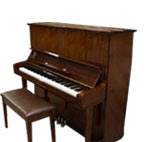Do you know how a young horse is “broke in” to the saddle? At first it seems to be impossible for him to become accustomed to those leather bands and buckles; they seem to bind and make him irritable. He is obviously out of control of his master. Yet, if you watch from time to time, as his master puts him into the harness, the young horse will become more and more used to the saddle until the time comes when the master can ride him with safety. The young horse is now under perfect control. He does his master’s bidding, and seems glad to do so. If his master had attempted to ride him at first, the horse undoubtedly would have thrown him and run away.
The same is true with our fingers. At first it seems that they will not strike the proper notes. But if we persevere, repeating particular passages in pieces of music, eventually our fingers become accustomed to striking the proper keys and gradually we attain the end for which we work, control of speed and accuracy of notes and fingering.
Now, we realize that, in the first attempts to practice a piece if you play fast most of the time in repeating it, accuracy of notes and fingering is not so easily attainable. Rather, you should practice slowly – and most often, very slowly – until the fingers follow a natural line of habit.
Here is a splendid and satisfactory way to practice for quick results: Take two or four measures at a time and carefully study these by practicing eight times slowly, afterwards once or twice faster. Then, take the next two of four measures in the same manner; and continue in this way until the last two measures of the piece are reached.
After this is well done, play from the beginning to the end of the piece, at least nine times very slowly. Try always to get the correct notes, and exercise much care not to fumble them. Then, play the piece through faster not more than three times. While you are playing faster, it would be advisable not to stop when a mistake is made but at the same time try to make it as near as possible like it should be when it is completed. In other words, play the piece just fast enough so that it is reasonably within your grasp.
Nine times slow and three times fast makes twelve times altogether. The piece should be practiced through from twelve to twenty-four times each day. As a result, we find a marked gain in speed, as well as accuracy of notes and fingering. The piece thus becomes so well prepared that it can be played with ease at any time. Try these piano finger exercises and see how you can improve your playing.









